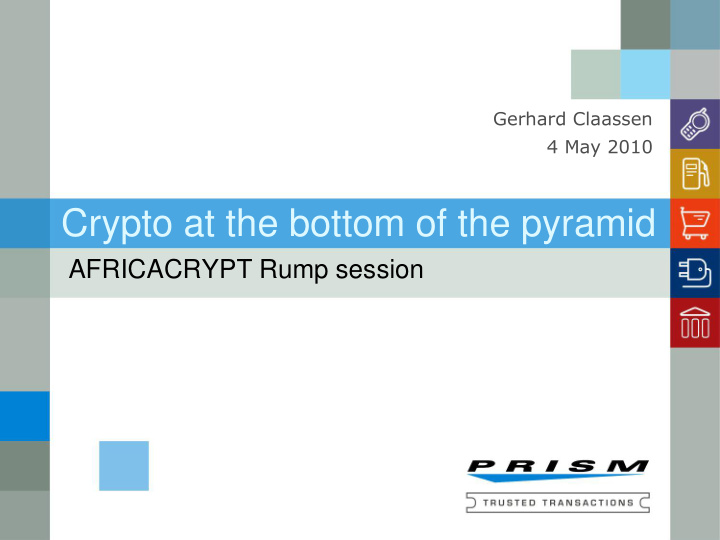



Gerhard Claassen 4 May 2010 Crypto at the bottom of the pyramid AFRICACRYPT Rump session
Motivation 1. Not a marketing presentation 2. Neither Northern Africa vs Southern Africa 3. Focus on the unique requirements of Africa 4. Socio economical perspective 5. Application of cryptography
World Economic Pyramid CK Prahalad, “Fortune at the bottom of the pyramid”.
CK Prahalad 1. This extreme inequity of wealth distribution reinforces the view that the poor cannot participate in the global market economy 2. Most Tier 4 people live in rural villages, or urban slums and shantytowns, and they usually do not hold legal title or deed to their assets 3. They have little or no formal education and are hard to reach via conventional distribution, credit, and communications 4. Fortunately, the Tier 4 market is wide open for technological innovation
What is needed is a better approach to help the poor, an approach that involves partnering with them to innovate and achieve sustainable win – win scenarios where the poor are actively engaged and, at the same time, the companies providing products and services to them are profitable.
Needs of the poor 1. The tier 4 poor also are unbanked 2. The do not have access to the financial system 3. They have a need to transact: 4. Receiving social grants and pensions 5. Paying for water and electricity 6. Buying food, etc
Social grants and pension payouts 13 million recipients in SA 4 million via one system Registration: ID, fingerprint, smart card Paypoints: ATM type terminals on pickup trucks in rural areas Authentication: Fingerprint and card Payout: 10 digit token, cash or transfer to wallet on card Wallet can be used to buy goods offline at participating stores Authentication between client card and merchant card currently 3DES based Moving towards Elliptic curve
High-level Key Negotiation Protocol
Pre-paid electricity The Standard Transfer Specification (STS) has become recognised as the only globally accepted standard for prepayment systems, ensuring inter- operability between system components from different manufacturers of prepayment systems. STS systems continue to be deployed around the world since 1993, with systems now in use in some 28 countries, including 17 on and around the African continent .
Prepaid Electricity Major Components A prepaid electricity system involves the following components: A pre-payment meter installed at the customer's residence. The meter accepts electricity tokens that transfer value to the meter. When the meter runs out of credit, it disconnects the electricity supply. A vending infrastructure that provides the customer with access to points-of-sale from where electricity tokens may be purchased. A management system to report on the vending infrastructure, perform financial reconciliations, configure system parameters such as tariffs and maintain the customer database. The management system can, as an option, interface to the supply authority's financial systems to provide financial integration with other services that the supply authority may provide. Meters
PIN Generation Processes STS Numeric Token or PIN
Thank you Any questions?
Recommend
More recommend